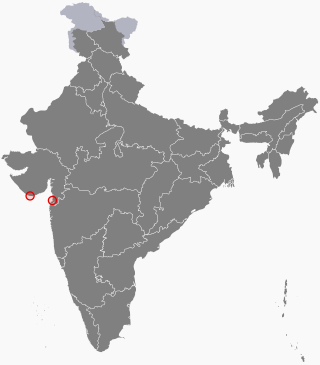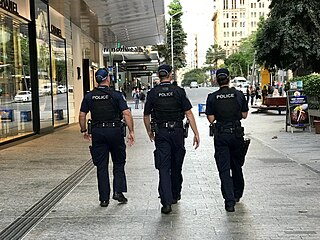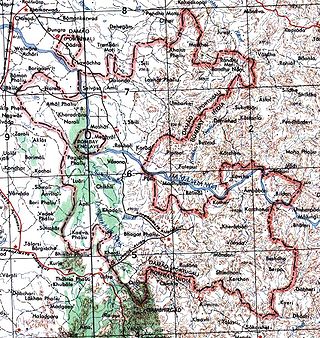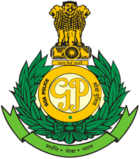
The Districts of Portugal, are the most important first-level administrative subdivisions of continental Portugal. Currently, mainland Portugal is divided into 18 districts.

Daman and Diu was a former union territory in northwestern India. With an area of 112 km2 (43 sq mi), it was the smallest administrative subdivision of India on the mainland. The territory comprised two districts, Damaon and Dio island, geographically separated by the Gulf of Khambat. The state of Gujarat and the Arabian Sea bordered the territory. A Portuguese colony since the 1500s, the territories were taken by India with the Annexation of Goa in 1961. Daman and Diu were administered as part of the union territory of Goa, Daman and Diu between 1961 and 1987, after the Goa Opinion Poll they became a separate union territory. In 2019, legislation was passed to merge the union territory of Daman and Diu with its neighbouring union territory, Dadra and Nagar Haveli, to form the new union territory of Dadra and Nagar Haveli and Daman and Diu with effect from 26 January 2020.

The State of India, also referred as the Portuguese State of India or simply Portuguese India, was a state of the Portuguese Empire founded six years after the discovery of a sea route to the Indian subcontinent by Vasco da Gama, a subject of the Kingdom of Portugal. The capital of Portuguese India served as the governing centre of a string of military forts and trading posts scattered all over the Indian Ocean.

The history of Goa dates back to prehistoric times, though the present-day state of Goa was only established as recently as 1987. In spite of being India's smallest state by area, Goa's history is both long and diverse. It shares a lot of similarities with Indian history, especially with regard to colonial influences and a multi-cultural aesthetic.

State police, provincial police or regional police are a type of sub-national territorial police force found in nations organized as federations, typically in North America, South Asia, and Oceania. These forces typically have jurisdiction over the relevant sub-national jurisdiction, and may cooperate in law enforcement activities with municipal or national police where either exist.

The National Republican Guard or GNR is the national gendarmerie force of Portugal.

Military Police are the preventive state police of the states and of the Federal District of Brazil. The Military Police units are the main ostensive police force at the state level and are responsible for policing and maintaining the public order. Their formations, rules and uniforms vary depending on the state. Investigative work and forensics are undertaken by the Civil Police of each state.

In Brazil, the Federal Constitution establishes eight law enforcement institutions - seven titulars and one auxiliar. The titular institutions are: the Federal Police, the Federal Highway Police, the Federal Railroad Police, the Federal Penal Police, the State Military Police and Fire Brigade, the State Civil Police and the State Penal Police. Of these, the first four are affiliated to federal authorities and the latter three are subordinated to state governments. These public safety institutions are part of the Executive branch of either federal or state government. Apart from these eight institutions, there are others which affiliate to municipal authorities: the Municipal Guards. According to Minister Alexandre de Moraes of the Supreme Federal Court, "...the Municipal Guards are inserted in public safety as the auxiliary and related body of public security force..." Federal law 13,022 gave them de facto and de jure police attributions.
This article is about the Caste System in Goa, and describes the various Jātis or sub-castes to be found among Hindus belonging to the four varnas, as well as those outside of them. A variation of the traditional Hindu caste system was also retained by the Goan Catholic community, and hence their castes are also mentioned in this article.

The Polícia de Segurança PúblicaMHTE is the national civil police force of Portugal. Part of the Portuguese security forces, the mission of the PSP is to defend Republican democracy, safeguarding internal security and the rights of its citizens. Despite many other functions, the force is generally known for policing urban areas with uniformed police officers, while rural areas are normally policed by National Republican Guard (GNR), a gendarmerie force. PSP is focused in preventive policing, only investigating minor crimes. Investigation of serious crimes falls under the Judicial Police responsibility, which is a separate agency.
Daman is one of the three districts of the Indian union territory of Dadra and Nagar Haveli and Daman and Diu on the western coast of India, surrounded by Valsad district of Gujarat state on the north, east and south and the Arabian Sea to the west. The district has an area of 72 square kilometres (28 sq mi), and a population of 191,173 at the 2011 census, an increase of 69.256% from the preceding 2001 Census. The district headquarters is Daman. The previous territorial headquarters were in Panjim when it was jointly administered as Goa, Damaon and Diu, until the time of the Goan Opinion Poll.

Diu district is one of the three districts of the union territory of Dadra and Nagar Haveli and Daman and Diu of India. The district is made up of Diu Island and two small enclaves on the Indian mainland. The district headquarters are at Diu Town. It is the ninth least populous district in the country.

The Annexation of Goa was the process in which the Republic of India annexed Estado da Índia, the then Portuguese Indian territories of Goa, Daman and Diu, starting with the armed action carried out by the Indian Armed Forces in December 1961. In India, this action is referred to as the "Liberation of Goa". In Portugal, it is referred to as the "Invasion of Goa". Jawaharlal Nehru had hoped that the popular movement in Goa and the pressure of world public opinion would force the Portuguese Goan authorities to grant it independence but since it did not have any effect, he decided to take it by force.
The Goa liberation movement was a movement which fought to end Portuguese colonial rule in Goa, Portuguese India. The movement built on the small scale revolts and uprisings of the 19th century, and grew powerful during the period 1940–1961. The movement was conducted both inside and outside Goa, and was characterised by a range of tactics including nonviolent demonstrations, revolutionary methods and diplomatic efforts. However, Portuguese control of its Indian colonies ended only when India liberated Goa in 1961 and incorporated the territories into the Indian Union.

The Annexation of Dadra and Nagar Haveli was the conflict in which the territories of Dadra and Nagar Haveli passed from Portuguese rule to independent rule, with Indian allegiance, in 1954.

The Public Security Police Force is the non-criminal police department of Macau and a branch of the Macau Security Force. Originally known at first as the Macau Police, the force went through several name changes before taking on its current name. The PSP celebrates its foundation on 14 March 1691.
Transportes Aéreos da Índia Portuguesa or TAIP was an airline which operated from Portuguese India from 1955 to 1961. During this period, it functioned as the state airline of Portuguese India, which comprised Goa, Daman and Diu.
Simbor is a territory of 0.91 square kilometres located in the estuary of the Sahil River in the cove of Simbor, about 25 km east of Diu. Since its establishment in the early 18th century, this exclave was subordinate to the District of Diu, Portuguese India, until it was occupied by India in December 1961, along with the rest of Portuguese India. Simbor is now part of the District of Diu, one of the three districts of the union territory of Dadra and Nagar Haveli and Daman and Diu.

Dadra and Nagar Haveli and Daman and Diu is a union territory in India. The territory was constituted through the merger of the former territories of Dadra and Nagar Haveli and Daman and Diu. Plans for the proposed merger were announced by the Government of India in July 2019; the necessary legislation was passed in the Parliament of India in December 2019 and came into effect on 26 January 2020. The territory is made up of four separate geographical entities: Dadra, Nagar Haveli, Daman, and the island of Diu. All four areas were part of Portuguese Goa and Daman with the former joint capital in Panjim, they came under Indian rule in the mid-20th century after the Annexation of Goa. These were jointly administered as Goa, Daman and Diu until 1987, when Goa was granted statehood after the Konkani language agitation. The current capital is Daman and Silvassa is the largest city.

















